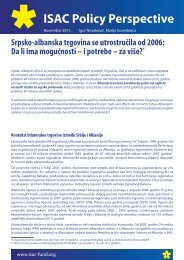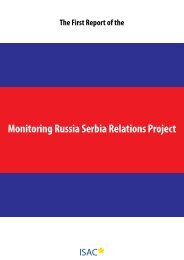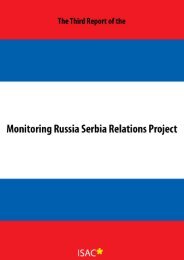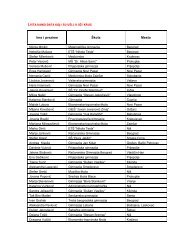the process of security sector reform - ISAC Fund
the process of security sector reform - ISAC Fund
the process of security sector reform - ISAC Fund
Create successful ePaper yourself
Turn your PDF publications into a flip-book with our unique Google optimized e-Paper software.
István Gyarmati MILITARY REFORMS OF THE 1990s: LESSONS LEARNED FROM THE SUCCESSES AND FAILURES<br />
István Gyarmati MILITARY REFORMS OF THE 1990s: LESSONS LEARNED FROM THE SUCCESSES AND FAILURES<br />
simply that it is very difficult and costly to meet <strong>the</strong>se requirements: no single<br />
country – with <strong>the</strong> possible exception <strong>of</strong> <strong>the</strong> United States <strong>of</strong> America – is able to<br />
do so. Therefore, international military cooperation becomes indispensable.<br />
People and institutions first, weaponry later<br />
Defense <strong>reform</strong> is a long and difficult <strong>process</strong>. In <strong>the</strong> best <strong>of</strong> <strong>the</strong> cases it lasts<br />
for six to eight years. To ensure long-term success, it is essential to create <strong>the</strong><br />
<strong>the</strong> best possible circumstances for attracting <strong>the</strong> necessary personnel, including<br />
<strong>the</strong> large number <strong>of</strong> non-commissioned <strong>of</strong>ficers (NCOs). Costly investments in<br />
weaponry can, and indeed should, wait until <strong>the</strong> personal is in place and trained<br />
and <strong>the</strong> necessary structures and command lines are created.<br />
SEVEN KEY ELEMENTS OF A MILITARY REFORM<br />
1. Establish a comprehensive and appropriate legal framework<br />
An adequate legal framework is indispensable for <strong>the</strong> <strong>reform</strong>. First, effective<br />
democratic political and civilian control must be established, including <strong>the</strong> introduction<br />
<strong>of</strong> <strong>the</strong> concept <strong>of</strong> „citizen in uniform”, which ensures that <strong>the</strong> human<br />
rights <strong>of</strong> every soldier are protected and ensured without endangering <strong>the</strong> effective<br />
functioning <strong>of</strong> <strong>the</strong> force–a huge task in itself. Next comes <strong>the</strong> necessary<br />
legislation regarding <strong>the</strong> peacetime functioning <strong>of</strong> <strong>the</strong> force, mobilization and<br />
wartime use. This is a vital and, at <strong>the</strong> same time, daunting task, which covers<br />
close to all aspects <strong>of</strong> legislation, since <strong>the</strong> armed forces are decisively different<br />
from <strong>the</strong> rest <strong>of</strong> <strong>the</strong> society. The necessary legislation should cover, in addition<br />
to <strong>the</strong> “logical” ones, major areas <strong>of</strong> law: policing (for <strong>the</strong> military police), <strong>the</strong><br />
judiciary system (for <strong>the</strong> court-martial system), healthcare and pensions (for <strong>the</strong><br />
specific needs <strong>of</strong> <strong>the</strong> military in military healthcare and <strong>the</strong> special retirement<br />
rules for <strong>the</strong> military), education (for military training schools), etc.<br />
2. Create a modern and flexible command structure<br />
It is essential to create a modern and flexible command structure, paying special<br />
attention to maintaing <strong>the</strong> unity <strong>of</strong> command, which will make it possible to<br />
command <strong>the</strong> forces in peacetime and, with few changes, in wartime. The<br />
command structure must take into account <strong>the</strong> perspective <strong>of</strong> an eventual<br />
international cooperation both in peace-time and in conflicts and will make it<br />
possbile, easy and effective. It is importnt that a civilian Ministry <strong>of</strong> Defense<br />
be created (that doesn’t mean that all employees <strong>of</strong> <strong>the</strong> Ministry <strong>of</strong> Defense<br />
must be civilians from <strong>the</strong> very beginning, but <strong>the</strong> institution itself and its legal<br />
status must be civilian and a significant numb er <strong>of</strong> its employess should also be<br />
civilians). The command and planning and organizational functions should be<br />
separated and this separation shluld be reflected institutionally as well.<br />
3. Develop an efficient defence planning system<br />
There is a need for a serious defense planning system, which should be created<br />
under <strong>the</strong> leadership <strong>of</strong> <strong>the</strong> Ministry <strong>of</strong> Defense. The former monopoly <strong>of</strong> <strong>the</strong><br />
General Staff in planning must be replaced by a cooperative effort, in which<br />
<strong>the</strong> civilian element takes <strong>the</strong> lead in determining <strong>the</strong> capabilities needed and<br />
cooperates with <strong>the</strong> military element in translating <strong>the</strong>se capabilities into forces,<br />
as well as determining <strong>the</strong> price tag for all projects.<br />
The defense planning <strong>process</strong> starts with <strong>the</strong> determination <strong>of</strong> <strong>the</strong> needs. These<br />
needs must <strong>the</strong>n be translated into specific programs, with a rigorous determination<br />
<strong>of</strong> <strong>the</strong> amount <strong>of</strong> resources necessary to implement <strong>the</strong>se programs.<br />
The results <strong>of</strong> this <strong>process</strong> must be compared and harmonized with <strong>the</strong> budgetary<br />
and o<strong>the</strong>r resources available. Such a <strong>process</strong> provides a clear picture <strong>of</strong><br />
<strong>the</strong> costs <strong>of</strong> certain capabilities, and this information enables <strong>the</strong> Parliament to<br />
make informed decisions on what capabilities will eventually be sacrificed, if<br />
budgetary constraints have to be imposed. The budget itself should be centered<br />
on <strong>the</strong>se needs and programs and must be transparent.<br />
4. Create a new system <strong>of</strong> human resources management<br />
An essential element <strong>of</strong> any <strong>reform</strong> is <strong>the</strong> <strong>reform</strong> <strong>of</strong> <strong>the</strong> human resource management<br />
system. The heritage <strong>of</strong> Communist human resource management is<br />
usually an army, which is top-heavy, meaning that it is overburdened by highranking<br />
<strong>of</strong>ficers (generals, colonels and lieutenant-colonels) and lacks junior<br />
<strong>of</strong>ficers and especially non-commissioned <strong>of</strong>ficers. The role <strong>of</strong> NCOs in this<br />
system is limited to auxiliary roles; <strong>the</strong>y are not part <strong>of</strong> <strong>the</strong> real command<br />
structures at all.<br />
The new human resources management system must provide for a sound and<br />
predictable career model, with enough incentives to attract <strong>the</strong> quality <strong>of</strong> people<br />
needed for <strong>the</strong> modern military. It must also be flexible enough to provide <strong>the</strong><br />
74 75

















